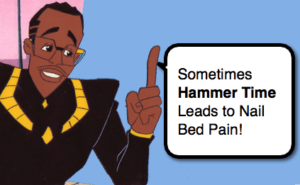Subungal Hematoma
 Kids love to explore their environment, but sometimes that environment (and their lack of agility and sluggish reflexes) leads to injuries. Fortunately, often these injuries are minor. Unfortunately, those minor injuries can lead to major headaches for you in your ED. One great example of that is the possible nail bed injury. Is that simple subungal hematoma really simple, or does it warrant a big procedures?
Kids love to explore their environment, but sometimes that environment (and their lack of agility and sluggish reflexes) leads to injuries. Fortunately, often these injuries are minor. Unfortunately, those minor injuries can lead to major headaches for you in your ED. One great example of that is the possible nail bed injury. Is that simple subungal hematoma really simple, or does it warrant a big procedures?
Some Number’s to Ponder
- Hand injuries are commonly seen in children. [Shah, 2012]
- In the US, from 1990-2009, ~16.4 MILLION kids were treated in EDs for hand injuries!
- That is equivalent to 2,243 children per day!
- Fingertip and nail bed injuries are some of the more common hand injuries in kids. [Gellman, 2009; Doraiswamy, 1999]
- The middle finger is most commonly injured finger (sometimes it isn’t beneficial to be longer).
The Nail Bed
- Fingertip injuries can be associated with nail bed injuries (in 15-24% of cases).
- A nail bed injury that is not managed correctly can lead to chronic deformity of the nail bed, nail plate, and finger tip. [Patel, 2014; Fairborn, 2012].
- This can also affect the finger’s function.
- Significant nail bed injuries can present in subtle ways initially (i.e., subungal hematoma).
Traditional Thought
- It is important to evaluate the nail bed for possible injury and repair them as needed.
- Obviously, if there is a laceration through the nail plate involving the nail bed, the nail plate needs to be removed and necessary repairs made, but…
- A “significant” subungal hematoma may indicate nail bed injury also.
- >50% of the nail surface
- >25% with an associated fracture.
- This would equate to needing to remove the nail plate in the setting of significant subungal hematoma.
- Certainly, EM physicians can manage these potential issues and have similar outcomes to other specialists, so there is no need to delay treatment by making consultant phone calls. [Al-Qadhu, 2011]
The Problem with Tradition
- Removing the nail plate is not easy in adults, and can be very challenging in children.
- Tiny digits with delicate structures are more challenging to manipulate.
- The procedure may also require sedation.
- Removing the nail plate may harm the nail bed even more.
- Again, dedicated structures don’t react well to giant instruments.
- Removing the nail plate leads to greater monetary expenses! [Roser, 1999]
Another Approach to Subungal Hematomas
- Based on current literature (as noted by Patel, 2014), in the setting of a Subungal Hematoma, the nail plate DOES NOT need to be removed if:
- If the nail plate is intact and at least partially adherent to the nail bed,
- AND
- If there is a fracture, it is not significantly displaced.
- Nail trephination has been shown to produce similar cosmetic and functional outcomes with no increased complications regardless of size of the subungal hematoma. [Roser, 1999; Meek, 1998; Seaberg, 1991]
- Stated another way, an uncomplicated subungal hematoma can be treated with simple trephination.
Nail Trephination
- Electrocautery device or red-hot paperclip can be used to create hole(s) in the nail plate to decompress the subungal hematoma.
- The procedure is rapid and the heat of the electrocautery/paperclip is dissipated by the hematoma so it does not damage the underlying nail bed. [Patel, 2014]
- A sterile needle can also “drill” through the nail plate, but care needs to be taken to not damage the underlying nail bed.
References
Shah SS1, Rochette LM, Smith GA. Epidemiology of pediatric hand injuries presenting to United States emergency departments, 1990 to 2009. J Trauma Acute Care Surg. 2012 Jun;72(6):1688-94. PMID: 22695442. [PubMed] [Read by QxMD]
Fairbairn N1. No such thing as “just” a nail bed injury. Pediatr Emerg Care. 2012 Apr;28(4):363-5. PMID: 22472652. [PubMed] [Read by QxMD]
Al-Qadhi S1, Chan KJ, Fong G, Al-Shanteer S, Ratnapalan S. Management of uncomplicated nail bed lacerations presenting to a children’s emergency department. Pediatr Emerg Care. 2011 May;27(5):379-83. PMID: 21494165. [PubMed] [Read by QxMD]
Roser SE1, Gellman H. Comparison of nail bed repair versus nail trephination for subungual hematomas in children. J Hand Surg Am. 1999 Nov;24(6):1166-70. PMID: 10584937. [PubMed] [Read by QxMD]
Meek S1, White M. Subungual haematomas: is simple trephining enough? J Accid Emerg Med. 1998 Jul;15(4):269-71. PMID: 9681314. [PubMed] [Read by QxMD]
Seaberg DC1, Angelos WJ, Paris PM. Treatment of subungual hematomas with nail trephination: a prospective study. Am J Emerg Med. 1991 May;9(3):209-10. PMID: 2018587. [PubMed] [Read by QxMD]


[…] get their hands into trouble frequently. Sometimes that injury can be relatively simple (ex, subungal hematoma), while other times it may be a little bit more challenging (ex, metacarpal fractures). […]
[…] situations and hazardous locations. Hand injuries are commonly encountered in our EDs (ex, Subungal Hematoma, Wrist Fractures) and, since the hand is such an important tool, it deserves specific attention. […]